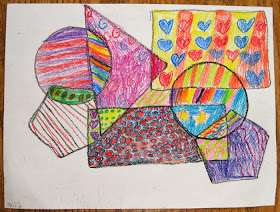On a day when I was subbing in a second grade classroom, wanting to do an art activity but not in the mood to bother with a full-blown lesson, I decided to focus on shapes and patterns. Usually when I do a patterning lesson, I get into a whole "math chat" mode and ask a lot of questions about what patterns are, how we know, and other identifying information. This time, I just put up a sheet of butcher paper, labeled it "Patterns in the Classroom" and asked students to describe, with words, patterns they could see around them. The key here was describing with words. I specifically asked them not to indicate what they were looking at, but simply to describe a pattern they found. As they described what they saw, I drew the patterns, as I understood them, on the paper.
Once we had several examples, I talked about how even if what I drew wasn't exactly what students saw, we still ended up with some interesting patterns. U explained that is called "getting an idea" or "getting inspiration" -- that the patterns they saw could be changed to create new patterns.
The actual art-making part of this activity was very simple: Trace some shapes onto white paper (I had brought my collection of cardboard and plastic shapes with me) and then color in the resulting spaces.
I introduced the words overlap and intersect and modeled tracing a few shapes to demonstrate the meanings of the words. I made sure students understood that each shape needed to overlap at least one other shape, so that all the lines would intersect. I then explained that each resulting shape/section would need to be filled with a pattern, and that no pattern could be repeated. And just to throw in another math concept, I asked them to trace an odd number of shapes, more than two and less than ten. They traced the shapes with a pencil first, then colored the spaces in, and then went back and outlined each original shape with a black crayon.
Students had cleared off their tables, so I just tossed a lot of assorted shapes in the middles of their tables and they went to work. As they got down to it, the classroom became quieter and quieter. There was some real concentration going on! A few students were not working real carefully, so I reminded them to be sure to think about what they were doing, and to slow down. I always tell students who rush that I am going to want their work to look like they were thinking about it. That generally works.
This was an easy, easy lesson that needed no prep at all. It would be great for a substitute (well, I was substituting!). I happened to have shapes with me, but I would bet that in most primary classrooms one would be able to find some shapes to trace. If not, students could make their own, with each student making one shape and then all students at that table sharing each others'. And there's no rule that says they have to use geometric shapes, but I do think the resulting shapes from overlapping are very interesting and it would be a great math extension to have them name all the resulting shapes, or some additional art concepts could be included by having students use all warm or all cool colors, or some other defined color combination.




